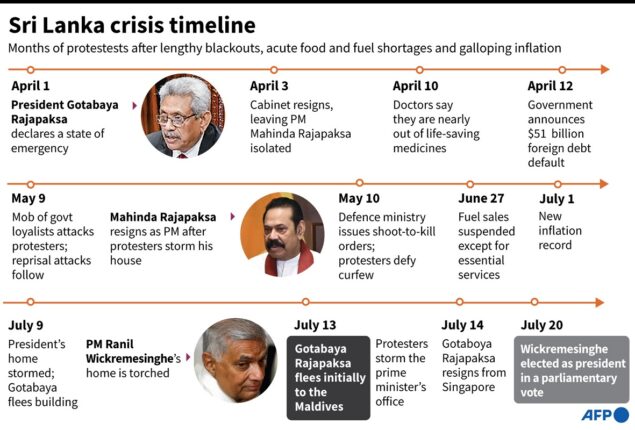Sri Lanka new president is elected by the parliament as protesters wait
According to numerous demonstrators, if one of the top two candidates, acting...

Sri Lanka: timeline of a crisis (Photo credits: AFP)
Sri Lanka: Ranil Wickremesinghe, Sri Lanka’s newly elected president, takes office in the midst of a severe political and economic crisis.
The 22 million-person island nation has seen severe shortages of food, fuel, and medication in addition to months-long blackouts.
The government’s handling of the situation, which was made worse by the loss of tourist dollars due to the Covid-19 outbreak, has been opposed by tens of thousands of people.
On July 13, after protesters had surrounded his home for several days, the former leader Gotabaya Rajapaksa left the country.
Rajapaksa declares a state of emergency after clashes between police and hundreds of demonstrators demanding his resignation outside his residence in the capital Colombo.
Most of the cabinet resigns at a late-night meeting, leaving Rajapaksa and his brother Mahinda — the prime minister — isolated.
The central bank governor resigns a day later.
Finance minister Ali Sabry resigns just a day after being appointed.
The president then loses his parliamentary majority as former allies urge him to quit. He lifts the state of emergency.
The government announces it is defaulting on its foreign debt of $51 billion.
Police kill a protester, the first casualty after several weeks of anti-government protests.
The next day, the IMF says it has asked Sri Lanka to restructure its colossal external debt before a rescue package can be agreed upon.
A mob of government loyalists bussed in from the countryside attacks peaceful protesters camped outside the president’s office.
Nine people are killed and hundreds more injured in reprisal attacks.
Mahinda Rajapaksa resigns as prime minister and has to be rescued by troops after thousands of protesters storm his Colombo residence.
He is replaced by Ranil Wickremesinghe, a political veteran who is also deeply unpopular among the protesters.
The defence ministry orders troops to shoot on sight anyone involved in looting or “causing harm to life”.
The United Nations warns that Sri Lanka is facing a dire humanitarian crisis, with millions already in need of aid.
More than three-quarters of the population had reduced their food intake due to severe food shortages, it says.
Rajapaksa flees his official residence in Colombo with the assistance of troops, shortly before demonstrators storm the compound.
Wickremesinghe’s residence is torched.
Rajapaksa flies to the Maldives on a military aircraft, accompanied by his wife and two bodyguards.
Six-time premier Wickremesinghe is appointed as acting president.
The government declares a state of emergency.
Protesters announce they will end their occupation of official buildings.
Rajapaksa leaves the Maldives for Singapore.
On arrival, he emails his resignation as president to the parliamentary speaker.
On July 18, Wickremesinghe renews the state of emergency.
Ranil Wickremesinghe, the law-and-order candidate, beats two opponents to be elected president by parliament.
“Our divisions are now over,” he declares.
He will serve out the remainder of Rajapaksa’s term, which expires in November 2024.
But whether Wickremesinghe will be acceptable to the protest movement remains to be seen.
Catch all the World News, Breaking News Event and Latest News Updates on The BOL News
Download The BOL News App to get the Daily News Update & Follow us on Google News.